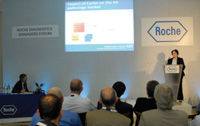The here and now of pathology reform: Part 2 – the pathology marketplace
19 Nov 2009 by Evoluted New Media
In this, the second instalment of our two part catch up with the movers and shakers in pathology, we learn that the changes afoot in this sector should be seen as an opportunity to bring it together
In this, the second instalment of our two part catch up with the movers and shakers in pathology, we learn that the changes afoot in this sector should be seen as an opportunity to bring it together
 The 2009 Roche Diagnostics Managers’ Forum ‘Reforming pathology: now and in the future’ was held recently at Somerset House, London, gathering senior pathology managers and key decision makers from NHS Trusts throughout the UK to discuss the pathology laboratory’s response to NHS reform and modernisation.
The 2009 Roche Diagnostics Managers’ Forum ‘Reforming pathology: now and in the future’ was held recently at Somerset House, London, gathering senior pathology managers and key decision makers from NHS Trusts throughout the UK to discuss the pathology laboratory’s response to NHS reform and modernisation.
Roche put together an interesting and practical programme, with expert speakers from within the NHS, Department of Health and the private sector, to inform and help equip laboratories for the road ahead. ‘The here and now of pathology reform: Part 1 – putting things in perspective’ (published in Laboratory News last month) reviewed the first half of the forum and provided a valuable overview of some of the drivers that are shaping the development of pathology services in the UK. Part 2 – the pathology marketplace describes the second session of the Forum, which was chaired by Dr Nick Summerton, a GP in the north of England and an advisor on Primary Care Diagnostics. This session explored the needs of pathology customers, particularly in general practice, and the marketing of pathology services in an increasingly competitive environment.
In his opening comments, Dr Summerton was able to provide a valuable insight into the role of pathology tests in general practice as he described the thought process when decisions about diagnostic testing are being made by GPs.
“When a GP considers a diagnostic test,” he explained, “he will be thinking about the purpose of the test; possible alternatives; the patient pathway; the setting in which the test is performed; and the future – how the result might affect what’s going to happen next.”
“In understanding its purpose,” he continued, “it is important to determine if the test is for diagnosis or exclusion? Is it for screening or monitoring? Is it to determine required levels of treatment or to help in prognosis?”
“A particular test is just one of several factors that, taken in combination, provide the full clinical picture. These factors include patient history, physiological testing, physical examination and imaging, and only occasionally will a pathology test be required. Even then,” he stressed, “it’s not about individual tests but about the combination of tests that have been performed along the patient pathway.”
provide the full clinical picture. These factors include patient history, physiological testing, physical examination and imaging, and only occasionally will a pathology test be required. Even then,” he stressed, “it’s not about individual tests but about the combination of tests that have been performed along the patient pathway.”
Dr Summerton observed that the day’s earlier proceedings left no doubt that change is inevitable. “Demographics are changing, therapeutics and biomedical understanding are changing, and diagnostic technology is changing. These things will all contribute to the development of pathology testing for primary care.”
“It is important to understand the needs of GPs when marketing pathology services to primary care commissioners,” he concluded before introducing the first speaker for the afternoon session, Mrs Barbara Bewley, operations manager for the Pathology Clinical Services at Cambridge University Hospitals NHS Foundation Trust.
Mrs Bewley was able to share from her own experience some of the issues to consider when marketing pathology services and the importance of understanding your marketplace.
“Our decision to market part of our pathology service was driven by government initiatives and targets,” she explained. “Also, as a result of the Darzi and Carter reports, pathology is going to be more patient centred. This will require improved access for patients to a modern and convenient pathology service.”
initiatives and targets,” she explained. “Also, as a result of the Darzi and Carter reports, pathology is going to be more patient centred. This will require improved access for patients to a modern and convenient pathology service.”
“It is important to provide people with what they need, where they need it,” she continued, “rather than telling people what you can provide, take it or leave it!”
Mrs Bewley went on to describe some of the issues that are driving change and shaping the provision of the pathology service for the future, such as funding, increasing demand, technological advances and changes in clinical practice. “On top of these,” she added, “the Carter review recommends consolidation of providers. This consolidation, together with the appearance of new entrants, will increase competition, which, in turn, should ensure better value for money for service users.”
“The dynamics of the market will be influenced by shifts in service provision as
 |
| “Demographics are changing, therapeutics and biomedical understanding are changing, and diagnostic technology is changing. These things will all contribute to the development of pathology testing for primary care” |
“As the GP service changes,” Mrs Bewley suggested, “so will their needs with regards to pathology.”
Having considered these and a variety of additional issues, a number of conclusions were drawn at Cambridge:
• the NHS laboratory of the future needs to be transformed into a commercially viable enterprise.
• GP business is at risk!
• We have spare capacity - we need to be more efficient.
• NHS providers will compete at tariff; what will separate one provider from another?
• We need to meet GP/PCT requirements.
• We need to market our pathology services.
“Ongoing dialogue with GPs, PCTs and practice based commissioners is essential to understand their needs,” Mrs Bewley concluded. “If we listen to what our customers need, we can utilise our skills to offer a complete and competitive service.”
“Marketing of our services should include improvements to the service, including IT and transport, and offering added value services, such as phlebotomy and point of care testing. These things should be part of the remit and under our control.”
Mr Phil Hudson, managing director of Collinson Grant Healthcare (management consultants to public and private healthcare organisations) concluded the day’s proceedings with a presentation on the ‘accurate costing of a pathology service’. He opened with a warning that, as a result of tightening budgets and calls for increasing efficiencies, the costs associated with pathology are likely to be reviewed – with a view to reducing them.
The definition of ‘cost’ in pathology is complex, he explained, and should include the cost of:
• Producing the test result.
• Interpreting the result.
• Transporting samples to the laboratory.
• Training and development of a multidisciplinary team.
• Laboratory costs, such as staff, equipment leasing and depreciation, etc.
• Trust overheads consumed by, and apportioned to, Pathology.
“Efficient and effective use of resources is essential,” Mr Hudson stressed. “Primary care directors of commissioning are likely to seek to obtain what some consider a ‘commodity’ service at less cost. They could do this by seeking lower prices and/or more services from their incumbent provider, or they could choose to commission services from the lowest-priced willing provider.”
“Savings in pathology are achievable by looking at the effectiveness of existing services,” he concluded. “The reduction of waste and careful consideration of desired outcomes will help managers to challenge the consumption of costs and to provide a more efficient and effective service.”
Dr Summerton brought the proceedings to a close by summarising the day’s events and reminding delegates of the challenge before them.
“We are going through a period of change,” he said. “There are changes in policy, patient expectations and technology. Either we can ignore it or we see it as an opportunity to engage – to begin that dialogue between providers and commissioners and to ascertain what we can do together, with the technology available, for the benefit of the patient.”
Mr Ian Parfrement, director of hospital in vitro diagnostics for Roche, commented, “This was a valuable opportunity to discuss the most important issues facing pathology today, to share from experience, and to look ahead at how we can work together to deliver a modern and effective service. Feedback from the forum was very good and reflected the quality and relevance of the presentations. Our thanks go to the chairmen and all of the speakers.”

